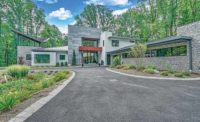Talk a bit about your company:
SBJ: I started the firm in 1967 by designing owner-occupied Brownstones, mostly on the West Side of Manhattan. All of this started with a Brownstone that I bought and renovated for his own family. Early on, I met developers who were starting to look at obsolete mercantile and industrial buildings. The 1960s and 1970s saw huge demographic changes. Industries were leaving metropolitan areas throughout the country, leaving empty buildings that could be bought for a small percentage of their replacement costs. This was the beginning of what today we call the Adaptive Reuse Industry, finding new uses for old buildings. I recognized the potential of using these buildings as a housing resource. My early projects have become textbook examples for Adaptive Reuse projects. For these efforts I was awarded the Andrew J. Thomas Pioneer in Housing award by the American Institute of Architects.
The firm has been credited with popularizing multi-level apartments as well as rooftop uses. All of this comes from working with 19th and early 20th century buildings, where generous vertical dimensions were much more abundant. My eureka moment came in the early 1970s when, standing on the roof of a full block-front loft building in the West Village measuring 200 by 100 feet deep, almost half an acre of empty space, I came to the realization that rooftops were the most underdeveloped real estate in the city. Since then, integrating rooftop uses into the program for virtually every project has become a hallmark iconic feature of the firm. Most importantly, they were responsible for creating the hotel rooftop craze because of the stunning success of the Hotel Gansevoort in the Meatpacking District, the building that changed the hospitality industry.
As I look back at my career, almost every decade pulled us in a different direction. In the 1970’s we focused on Adaptive Reuse, designing projects in New York City but also Patterson NJ, Norwich CT, and Upstate NY.
In conceptualizing our early Adaptive Reuse projects, I was forced to learn the real estate business. Developers would bring me buildings and tell me, “I can buy this building but I don’t know what I can pay for it,” because a building is only worth what you can do with it. It was therefore necessary to translate architectural layouts into dollars and cents. In the early 1980s I started to use the experience I had gained to develop properties for our own account. These projects were very specialized, using historic tax credits to raise the equity required to restore landmark buildings in two Downtown Brooklyn Historic Districts. Our projects were the catalyst for the development of Fort Greene and Clinton Hill.
Unfortunately the 1980s did not end well, and at the end of the day I came to the conclusion that we were doing too much, and one has to focus on what they do best. And what we do best is being architects. On the other hand, the experience completely changed the way we think, design and communicate. It made us a builder’s architect. Today our clients are some of the largest developers in the region.
In the mid-1990s our focus changed to hotels. This was the beginning of the development of boutique or lifestyle hotels. Once again we were early in what would become a new trend. We designed some of New York City’s earliest boutiques, including Sixty Thompson, The Library Hotel, and Hotel Giraffe, and finally the Gansevoort in the Meatpacking District, as well as other Gansevoort Hotel locations. We also started designing newly constructed residential projects for all market segments, from affordable housing to some of the most expensive apartments in the city. The scale of our projects continued to grow, and the buildings started to get taller, some as tall as 50 to 60 stories. Last year the firm celebrated its 50th anniversary since its founding, and we look forward to many more years.
How did you first develop an interest in architecture?
SBJ: I came from a medical family but I personally never wanted to be a physician. Ever since I was a kid I enjoyed drawing and painting and saw myself as an artist. After high school I attended The Art Students League of New York, studying with Frank Mason, an academic landscape and portrait painter. All he talked about was architecture and it stirred my interest. Deep down inside I knew I was a lousy painter.
How often does your firm use stone (or tile) in its designs?
SBJ: We have always used stone extensively in its many iterations, both on the interior and exterior of buildings. We have used limestone extensively for interiors and exteriors of buildings. Recently my wife Andi Pepper, our affiliated interior designer, and I designed a new house for ourselves on a heavily-wooded lot overlooking the Connecticut River. There were existing hundreds of feet of old stone walls as well as large boulders and rock outcroppings. We used the fieldstone recovered from the stone walls on the front façade of the house, as well as a massive two-story wall in the living room juxtaposed against a huge limestone fireplace surround. The boulders as well as large granite blocks (very similar to Stony Creek granite) that were recovered from blasting a cellar for the house were used for retaining walls and landscaping.
What are some stone and/or tile trends you are seeing in the Kitchen and Bath sector of the market?
SBJ: Kitchens and baths cover a huge range and can vary dramatically depending on the target market. In luxury housing and condominium projects, we are seeing stone used extensively for flooring, countertops, full backsplashes, ornamental walls, and so on. Bathrooms, particularly master bathrooms, are being designed with most walls sheathed in stone or tile running from floor to ceiling. Even in affordable housing we are starting to see granite countertops in kitchens, and many other details that were formerly only provided in market-rate housing.
What are some stone and/or tile trends you are seeing in hospitality?
SBJ: More or less similar to what is happening in the housing market, except with hospitality projects porcelain tile is being used extensively. Every year there are new tile patterns and larger and larger sizes which open up new opportunities and endless possibilities.
What advice would you offer to a young architect?
SBJ: Architectural firms tend to be one of two extremes. They are either the fancy design firm who only thinks about how things look but have little interest in the intricacies required to build a building. On the other hand we have, let’s say, the businessman’s architectural firm. They know how to design buildings that come in on time and on budget but at the end of the day they don’t look like anything. My advice to young architects is to find a middle ground, hone your design skills, and always strive to create the best possible building. But at the same time become technically proficient, and learn and understand what all of the consultants are doing. You cannot be the team leader if you don’t have the knowledge to actively contribute to the myriad decisions that have to be made to construct a building.







